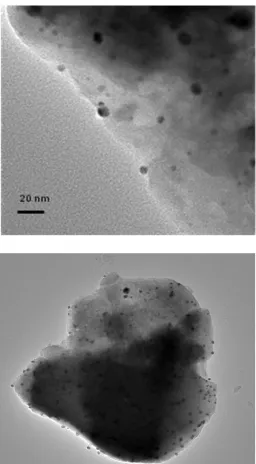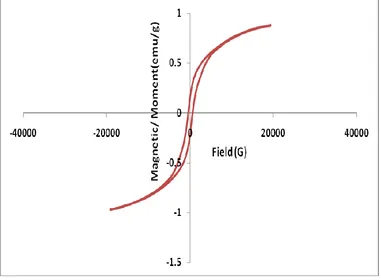Int. J. Electrochem. Sci., 6 (2011) 6177 - 6183
International Journal of
ELECTROCHEMICAL
SCIENCE
www.electrochemsci.org
Short Communication
Synthesis and Characterization of Magnetite Zeolite Nano
Composite
Taher A. Salah El-Din1
, Ahmed A. Elzatahry2,4,*, Daifallah M. Aldhayan3, Abdullah M. Al-Enizi2 and Salem S. Al-Deyab2
1
Regional Center for Food & Feed,Agricultural Research Center, 9 El Gamaa St., Giza, Egypt.
2
Petrochemical research chair, Department of chemistry, King Saud University, PO Box: 2455, Riyadh 11451, Riyadh, Kingdom of Saudi Arabia.
3
Department of chemistry, King Saud University, PO Box: 2455 Riyadh 11451, Riyadh, Kingdom of Saudi Arabia.
4
Advanced Technology and New Materials Research Institute, City of Scientific Research and Technology Applications, New Boarg El-Arab City, Alexandria, Egypt.
*
E-mail: aelzatahry@ksu.edu.sa
Received: 27 September 2011 / Accepted: 5 November 2011 / Published: 1 December 2011
Keywords: Zeolite, Magnetite, Nanocomposite, VSM, nanomaterials
1. INTRODUCTION
The use of nanotechnology has shown a high impact on society and environment, nanomaterials showed differences in shape, size, activity, conductivity, and many other properties than bulk materials [1] . It has become a part of high changes in different applications such as energy [ 2,3], sensors [4], medicine [5], construction [6], Bio-applications [7], Food [8] and water treatments [9]. In recent years, different synthetic routes have followed to prepare nanomaterials such as chemical methods, microwave and laser ablation method [10]. Scientists show high interest for magnetic nanomaterials due to its potential applications, also bulk materials could show a high super magnetic or magnetic resistance, when prepared in nanoscale [11].
Zeolite with its well defined structure and microporous cavities work as a good candidate for nanoparticles support and hosting [11-13]. The interaction of nanoparticles in both form of metal and metal oxide with zeolite has opened a new window of applications such as sensors, electronics and magnetic applications [11 ]. It was reported that zeolite exhibit magnetic property by its loading with CO [11].
In this study, we report the synthesis of zeolite doped magnetite nanoparticles as well as the magnetic properties of the prepared samples, which has been prepared by chemical route.
2. EXPERIMENTAL
2.1. Zeolite Preparation
In a typical synthesis procedure, An exact amount of NaOH solution was added to Pyramid sodium silicate (Crossfield chemicals.) under stirring at room temperature, then a mixture solutions of NaAlO2 and TPAOH were added individually with vigorous stirring. The reaction kept under stirring
for at least 2 hours and then transferred into a 250 ml Teflon-lined steel autoclave. Reaction kept at 170 °C under pressure for 24 h. The product was filtered, rinsed with deionized water, dried, and calcined at 540 °C for 8 hours to remove the template.
2.2. Zeolite loading of magnetite nanoparticles
A certain amount of Iron chloride equal to obtain final loading of 1% and 2 % Fe3O4 was added
to distilled water, and stirred for 30 min, 2 g of calcined zeolite was flooded in the above solution after heat treatment at 150 °C under vacuum over night.
2.3 Physical characterization of the nanocomposites
The particle size and the morphology of the prepared catalysts were characterized by High Transmission Electron Microscope (TEM) (Philips). The measuring mode of the sample in TEM instrument depends on its suspension in water followed by ultrasonication for 600 s in ultra 8050-H Clifton. It was then applied in the TEM instrument on 100 mesh copper grade coated with carbon. Powder X-ray diffraction (XRD) patterns were recorded with a PANalytical: X'Pert PRO diffractometer using Cu Kα radiation source for the investigation of crystalline structure and phase. Magnetic properties were determined using Vibrating Sample Magnetometer (VSM)-LAKESHORE.
3. RESULTS AND DISCUSSION
3.1. Physicochemical characterization of nanocomposite
Fig. 1 shows the low-angle XRD patterns corresponding to the prepared magnetite and formed nanocomposite. Fig.1A shows, the sum of reflection intensities at 2θ of 30°, 35.5°, 43.0°, 57.0° and 63.0° corresponding to (2 2 0), (3 1 1), (4 0 0), (5 1 1) and (4 4 0) planes of cubic crystal system as shown in fig (1.A) for prepared magnetite indicate the formation of cubic crystal iron oxide Fe3O4,
which confirmed by standard data for magnetite ( ref: 04-007-1060). Also Fig. 1B showed the formation of the cubic aluminum zeolite [Al]-ZSM-5. The intensities of the peaks sample are relatively high as indication of high crystallinity. The formed zeolite is a mixture of sodium aluminum silicate and sodium aluminum oxide silicates, which is confirmed by standard data for zeolite ( ref’s: 00-045-0437 & 01-076-0591). Also it has been observed that the intensity of magnetite peaks has decreased, during its presence in the nanocomposite as an indication of incorporation within pores of zeolite.
Figure 1. XRD patterns of (A) magnetite and (B) Magnetite/Zeolite. A
[image:3.596.114.465.512.726.2][image:4.596.171.427.162.626.2]
The preparation method followed in this work produced a uniformly dispersion of small particles around 4-6 nm of magnetite nanoparticles on zeolite as shown in TEM images in ( Figure 2) The formation of small nanoparticles may help the incorporation of magnetite nanoparticles within zeolite framework as also indicated by XRD measurements.
Figure 2. TEM micrographs nanocomposite formed by zeolite doped nanomagnetite
3.2. Magnetic characterization of Nanocomposite
nanomagnetic composite are shown in figures 3, 4, where the magnetization hysteresis loops appeared S-like.
[image:5.596.112.487.129.386.2]Figure 3. M–H hysteresiscurves for Nnaomagnetites
[image:5.596.109.490.439.719.2]
From figure 3, it explains the soft magnetic nature of formed magnetite, it is observed that the magnetization is completely saturated at value of 30 emu/g for pure magnetite, while in case of nano magnetic composite, the magnetization is not completely saturated .
Table 1 summarizes the values of Coercivity (Hci), Magnetization (Ms) and Retentivity (Mr) for pure nanomagnetite and nanomagnetic composite materials, which obtained from VSM. The sharp decrease in Ms value for the nanomagnetic composite maybe due to the incorporation of the
nanomagnetite within the framework of zeolite structure, walls of zeolite act as a shield for magnetic power of nano Fe3O4. Another explanation of low saturation magnetization is may be due to well
[image:6.596.63.536.302.405.2]dispersion of nanoparticles in zeolite matrices, which lead to mot easy formation of magnetic domain [14].
Table 1. VSM measurements values for nanomagnetite and nano magnetic composite
Magnetite only 1% Magnetite/
Zeolite
2% Magnetite/ Zeolite
Coercivity (Hci) 267.52 G 592.09 G 516.56 G
Magnetization (Ms) 30.395 emu/g 0.85358 emu/g 0.92529 emu/g Retentivity (Mr) 6.0871 emu/g 0.18880 emu/g 0.18535 emu/g
4. CONCLUSION
Nanocomposite of zeolite and nanomagnetite has been prepared by a simple chemical route, the prepared nanomagnetite has a uniform particle size of 4- 6 nm, the X-ray diffractometer proved that the formed magnetite is a cubic Fe3O4. It showed also the possible incorporation of formed magnetite
within the frame work of zeolite, VSM study showed a sharp decrease in magnetic power that has been observed upon the loading of magnetic nanoparticles on zeolite.
ACKNOWLEDGMENT
This project was supported by King Saud University, Deanship of Scientific Research, College of Science Research Center.
References
1. P. Murphy, D. Munshi, P.A. Kurian, A. Lakhtakia, R.V. Bartlett, Comprehensive Nanoscience and Technology, Volume 5 (2011) 443-476
2. Elena Serrano, Guillermo Rus, Javier García-Martínez , Renewable and Sustainable Energy Reviews, 13 (2009) 2373-2384.
4. Sharon Smith, David J. Nagel. “Chapter 21 – Nanotechnology-Enabled Sensors: Possibilities, Realities, and Applications” Sensor Technology Handbook, 2005, Pages 563-574
5. Mihail C Roco, Current Opinion in Biotechnology, 14 (2003)337-346
6. Florence Sanchez, Konstantin Sobolev, Construction and Building Materials, 24 (2010) 2060-2071 7. Yu.I. Prylutskyy, V.M. Yashchuk, K.M. Kushnir, A.A. Golub, V.A. Kudrenko, S.V. Prylutska, I.I.
Grynyuk, E.V. Buzaneva, P. Scharff, T. Braun, O.P. Matyshevska , Materials Science and Engineering: C, 23 (2003) 109-111
8. Michael Siegrist, Nathalie Stampfli, Hans Kastenholz, Carmen Keller, Appetite, 56 (2011) 78-89 9. J. Antonio Rivera Márquez1, C. Moisés Bautista Rodríguez, Consuelo Mendoza Herrera, Efraín
Rubio Rosas, Orlando Zelaya Angel, Omar Tzili Pozos,Int. J. Electrochem. Sci., 6 (2011) 4059 – 4069
10.Garry Glaspell, Hassan M. A. Hassan, Ahmed Elzatahry, TOPICS IN CATALYSIS, Volume 47, Numbers 1-2, 22-31
11.P.G. Bercoff, H.R. Bertorello, C. Saux, L.B. Pierella, P.M. Botta, Toshiyuki Kanazawa, Ying Zhang, J. Magn. and Magn. Mater. 321(2009) 3813-3820
12.M. Mazloum- Ardakani1, Z. Akrami, H. Kazemian and Hamid. R. Zare, Int. J. Electrochem. Sci., 4 (2009) 308 – 319
13.Y. Zhan, F. Meng, X. Yang, X. Liu, , Colloids and Surfaces A: Physicochemical and Engineering Aspects (2010), doi:10.1016/j.colsurfa.2011.09.013
14.Vero´nica R.Elı'as, MarcosI.Oliva, ElianaG.Vaschetto, SilviaE.Urreta, Griselda A.Eimer, SilviaP.Silvetti, Journal of Magnetism and Magnetic Materials 322 (2010) 3438–3442



